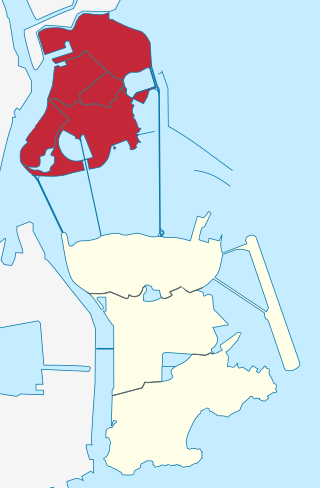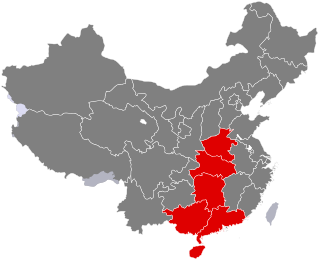
The special administrative regions (SAR) of the People's Republic of China are one of four types of province-level divisions of the People's Republic of China directly under the control of its Central People's Government, being integral areas of the country. As a region, they possess the highest degree of autonomy from China's central government. However, despite the relative autonomy that the Central People's Government offers the special administrative regions, the National People's Congress and its Standing Committee remains capable of enforcing laws for the special administrative regions.

"Mainland China", also referred to as "the Chinese mainland", is a geopolitical term defined as the territory under direct administration of the People's Republic of China (PRC) in the aftermath of the Chinese Civil War. In addition to the geographical mainland, the geopolitical sense of the term includes islands such as Hainan, Chongming, and Zhoushan. By convention, territories outside of mainland China include:

The Macau Peninsula is the historical and most populous part of Macau. It has an area of 8.5 square kilometers (3.3 sq mi) and is geographically connected to Guangdong Province at the northeast through an isthmus 200 meters (660 ft) wide. The peninsula, together with downtown Zhuhai, sits on an island separated from the continent by distributaries of the Pearl River. The Border Gate was built on the northern isthmus. At the south, the peninsula is connected to Taipa Island by three bridges, the Friendship Bridge ; the Macau-Taipa Bridge ; and the Sai Van Bridge . The longest axis extends 4 kilometers (2.5 mi) from the Border Gate to the southwestern edge, Barra (媽閣嘴). There is a western "Inner Harbor" (內港) paralleled by an "Outer Harbor" (外港) to the east. The 93 meters (305 ft) Guia Hill (松山) is the highest point on the peninsula, which has an average elevation of 50 to 75 meters. Many coastal places are reclaimed from the sea. The Historic Centre of Macau, which is entirely on the Macau Peninsula, became a World Heritage Site in 2005.
The Han Chinese people can be defined into subgroups based on linguistic, cultural, ethnic, genetic, and regional features. The terminology used in Mandarin to describe the groups is: "minxi", used in mainland China or "zuqun", used in Taiwan. No Han subgroup is recognized as one of People's Republic of China's 56 official ethnic groups, in Taiwan only three subgroups, Hoklo, Hakka and Waishengren are recognized.

The Municipality of Ilhas was one of the two municipalities of Macau, along with the Municipality of Macau. Its organs were the municipal council and the municipal assembly. Per Law No. 17/2001, the two municipalities were abolished on December 31, 2001 and replaced by the Instituto para os Assuntos Cívicos e Municipais the following day.

The Municipality of Macau was one of two municipalities of Macau, along with the Municipality of Ilhas.

The time in China follows a single standard time offset of UTC+08:00 based on the National Time Service Center of Chinese Academy of Sciences located in Mount Li, Lintong District, Xi'an City, Shaanxi Province, even though the country spans almost five geographical time zones. The official national standard time is called Beijing Time domestically because based on 120th meridian east that Beijing City is located, and China Standard Time (CST) internationally. Daylight saving time has not been observed since 1991. China Standard Time (UTC+8) is consistent across Mainland China, Hong Kong, Macau, Taiwan, as well as equivalent with Philippines, Singapore, Brunei, most of Mongolia, Malaysia, Irkutsk Time (Russia), Western Australia and Central Indonesia.

Telephone numbers in Macau are eight-digit numbers. Fixed land line numbers start with 28, while mobile (cellular) phone numbers start with 6. Calls from Macau to mainland China, Hong Kong, Taiwan and Portugal are treated as international calls.

Chinese nationality law details the conditions by which a person holds nationality of the People's Republic of China (PRC). The primary law governing these requirements is the Nationality Law of the People's Republic of China, which came into force on September 10, 1980.

South Central China or Central-South China, is a region of the People's Republic of China defined by the State Council that includes the provinces of Guangdong, Hainan, Henan, Hubei and Hunan, as well as the Guangxi Zhuang Autonomous Region; in addition, the two provincial-level special administrative regions (SARs), Hong Kong and Macau, are also included under South Central China.

Taiwan Province, PRC refers to a notional administrative division claimed by the People's Republic of China. The PRC constitution asserts Taiwan as part of its territories although the PRC has never controlled Taiwan since the PRC's establishment in 1949. The territory of the claimed province, including the entire island of Taiwan, is in actuality administered by the Republic of China (ROC) but is not coextensive with the smaller Taiwan Province of the ROC.

The Macau Resident Identity Card or BIR is an official identity card issued by the Identification Services Bureau of Macau. There are two types of Resident Identity Cards: one for permanent residents and one for non-permanent residents.

South China is a geographical and cultural region that covers the southernmost part of China. Its precise meaning varies with context. A notable feature of South China in comparison to the rest of China is that most of its citizens are not native speakers of Standard Chinese. Cantonese is the most common language in the region while the Guangxi region contains the largest concentration of China's ethnic minorities.

Secession in China refers to several secessionist movements in the People's Republic of China. Many current separatist movements in China arise from the country's ethnic issues. Some of the factors that have created these ethnic issues include history, nationalism, economic and political disparity, religion, and other factors. China has historically had tensions between the majority Han and other minority ethnic groups, particularly in rural and border regions. Historically, other ruling ethnicities, such as the Manchu of the early-Qing dynasty, experienced ethnic issues as well.












